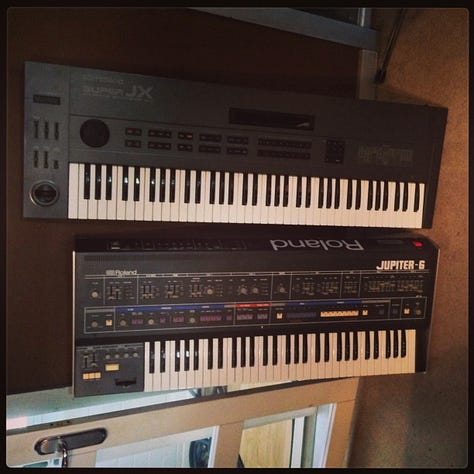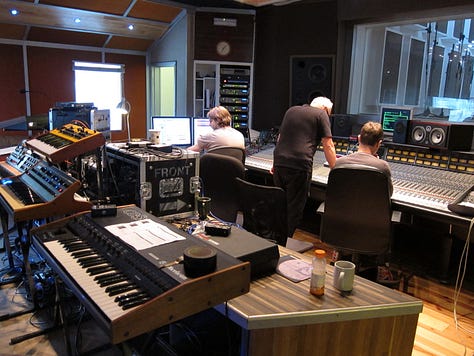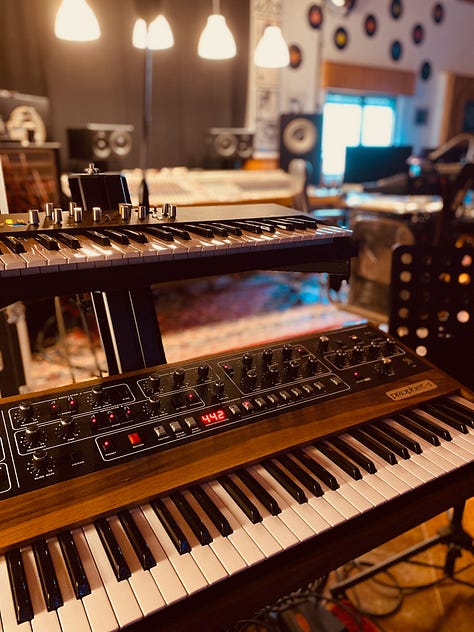My love affair with analog synthesisers
At first, love affairs are very intense and all consuming but with time the magic can fade. Can the passion be rekindled?
Firstly, I need to apologise for not creating my regular bi-monthly post. We have been mixing our new record and it’s been very intense, to say the least! But now onwards…
I started to listen to music seriously around 1972. I was 14.
Quickly becoming gripped with the guitar I spent all my waking hours between school lessons playing and trying to emulate my heroes: Jimmy Page, Richie Blackmore, Andy Powell, Tony Iommi, Carlos Santana, Alvin Lee and David Gilmour - the latter giving me a full-on introduction to the weird and wonderful, otherworldly timbres of Pink Floyd.
How did bands create the strange and mysterious sounds? There was no internet, hence no Wikipedia or YouTube and I had to rely on articles in the music magazines at the time to glean my information.
At boarding school I was deluged by music: everyone was listening to something cool and had a favourite, keen to share their new discovery with anyone that would listen. This is where I bumped sonically into Genesis and Emerson Lake and Palmer (ELP).
In the early 70s, the live scene was very hot and virtually everyone who was anyone was touring medium-sized venues and I became addicted to live gigs.
Being at school in Southport, my local venue was the Empire in Liverpool. It was here I saw Pink Floyd in 19741 and around the same time ELP and Genesis.
All three bands really turned me onto the sound of the synthesiser, but it was Keith Emerson who really got me.
I saw him unceremoniously dump one of his two Hammond L100s into the orchestra pit whilst his other was screaming two notes held down by the famous Nazi dagger that Lemmy had given to him whilst working as a roadie with Emerson’s former band, The Nice.
This was pure spectacle, but it was the Mini Moog and monster modular synthesiser that captured my imagination. Soaring lead lines, thunderous noises and things that went ziza, ziga, ziga. Accompanied of course by constant tuning up: heat and early analog synths didn’t really mix that well!
When I returned to school, I dreamed of those sounds, but like some love affairs the feelings waned and I continued on my guitar-playing odyssey, until…
The Flying V incident
My first proper guitar was a Gibson Flying V that my parents bought for me for my 17th birthday. I was a lucky lad.
Inspired by Andy Powell of Wishbone Ash, I played it to death. So much so that after just two years I had Ted Lee re-fret the instrument and had it refinished in translucent red and a Maestro Vibrola fitted, just like Andy’s.
My first original band was hard rockers Whitefire, which morphed into a punk R&B band called Roadrunner with the same lineup: the late, great Jim Beswick (bass), Eddie Byron Taylor III (drums - real name) and Tim Wright on vocals.
After many years on the road we decided to call it a day and Tim and I struck out to find a new direction, and a record deal.
We practiced at Jamm Studios, a dedicated rehearsal studio in an old mill in Bolton, Lancashire which had a musical instrument shop above it. I remember going up there one day, post-rehearsal and saw an Oxford Synthesiser Company OSCar - I managed to fire up the arpeggiator and fell in love. Big, thick analog sounds and perfect for our new EuroPop direction, so guess what, I part exchanged the Flying V.
My dad went berserk - as only Joseph Campbell could - his bald head going completely purple. I told him it was the right thing to do: we were going electro-pop.
Well, it wasn’t the right thing to do (he was usually right) and a couple of weeks later I went into the shop to buy it back only to find they had sold it on to a shop in Northwich. Holy mother of fuck!!!
I hot-tailed it down there to see it on the wall and negotiated a deal to return it to its rightful owner, i.e. me.
OSCar in hand I regularly drove over to Tim’s house to write and he often came to us. This was the embryonic start of the band Little Brother.
I can’t remember how and why I sold that synth - drugs are a dreadful thing - but I remember it being fantastic and wish I still had it.
The drum machines
We finally were offered the deal we wanted and the band invested in a Yamaha RX-7 plus a four-track TASCAM Portastudio for demos.
By this time Tim and I had been joined by keyboardist Steve Dowd, who brought in his Yamaha DX7 and Roland Juno-6, the former using FM synthesis - and all the rage back in the 80s.
Tim, Steve and myself would make our demos and then send them down to Derek (Lawrence) and Big Jim (Sullivan) for feedback. I gravitated to the drum programming as I seemed to just ‘get it’.
The time came to record the album and Big Jim was doing a lot of programming on his ATARI ST - remember those? - and we were joined by drummer Graham Middleton and bass player Gary Short.
Things were getting serious and Steve bought a bunch of AKAI S900 samplers and Oberheim Matrix 1000s plus, if my memory serves me correctly, an AKAI ASQ10 hardware sequencer, known as the highly important box, without which the gig couldn’t go ahead. Those were the days.
Sadly after the album was completed the band split for various reasons that we won’t go into here and I returned to the world of guitars, bass and drums.
Electrolite
Fast forward from the early 90s to 2010 when I encountered my now wife, Suzy Starlite, on the Isle of Man.
Not long after we met, I encouraged her to take her acoustic-based songs into a full band environment. You guessed it - drums, bass, Starlite on acoustic guitar and me on electric.
We agreed that I would produce some demos. When we were recording, that synthesiser feeling came over me again and we promptly enlisted our good friend Mark Cleator to play with us who has a wonderful array of old analog synths. Once finished, we decided to create a side project Electrolite - with Suzy, Mark and myself.
I was just finishing my second solo album - The Knife - at the wonderful Chairworks studio in Castleford, England and booked another few days to record the material we had been working on.
Mark came over from the Isle of Man with a massive array of keyboards jam-packed to the roof of his vehicle and along with the gear that was already in the studio, we had a totally amazing time making the EP.



I was producing the record and along with electric and Moog guitar, added some bass - using a Dave Smith Instruments (which became Sequential) Mopho - and programmed the drums into our newly acquired Sequential Tempest drum machine.
This was a first for me, actually playing a keyboard. I liked it.
Of course with a real Mellotron in the house, it had to be used. This is a quick video of Mark laying down the parts to Take Me Now.
We were delighted with the songs and released the EP on the classic format of 180g vinyl at 45 rpm.
Here is a track from the session and the one Starlite and I used to walk into the ceremony on our wedding day.
Sequential
We sold our original Sequential Tempest drum machine to fund, if I remember correctly, a compressor that was needed for the studio. It was a hideous mistake as we were writing a lot of material at the time and there is nothing better to assist the process of composition than a cool drum box.
One day I am going to write an article on all the gear I have sold and regretted later: it will be a long one.
Before we sold it, Suzy and I recorded this - our first dalliance with electronic drums as Starlite & Campbell - look out for the 35Hz Tempest kick.
Anyway, a while later we contacted Sequential who, hearing what we were doing, asked us if we wanted to become Sequential artists. Holy shit, of course! The new machine arrived and it felt like an old friend.
What I didn’t really get the first time around is that it can be used as a great polyphonic synthesiser as well, but I will get to this in a bit.
Starlite & Campbell
The Language of Curiosity was the second studio album from the Starlite Campbell Band where, from a songwriting and production perspective, we moved one step on from our first, Blueberry Pie.
I employed the Tempest on two tracks - It Ain’t Right - blended with Steve Gibson’s lovely drum part and to beef up the snare in Ride On Cowboy.
Making a debut on the record was our new acquisition, the totally analog Moog Minitaur which featured in the psyched-out middle section of Said So and a ‘duga duga’ sound in Ride on Cowboy - I think you can see where I am going here.
Starlite.One
In line with our new multi-media project Starlite.One, Starlite and I wanted to create something really different on the new studio album and put together a really eclectic playlist to inspire us. It contained everything from Silver Apples to Os Mutantes, Low to Ryuichi Sakamoto, Arvo Pärt to Roxy Music and that’s just the tip of the iceberg. Starlite named it Six Friendly Monkeys living under the stairs.
We wanted to create a more textured production, with guitar motifs rather than solos, synths, grinding bass and ratcheted-up acoustic drums, bringing in Hugo Danin - probably the best drummer in Portugal, if not Europe - who contributed a more jazz-rock-afrobeat fusion groove to proceedings.
So here it is, the love affair is rekindled!
In addition to the Sequential Tempest and monophonic Moog Minitaur, we acquired four new instruments: a polyphonic Waldorf STVC and new Sequential Prophet-5 plus paraphonic Moog Matriarch and a vintage, non-MIDI, Moog Opus 3.
I am of course principally a guitar player but really buckled down to practising some piano and teaching myself how to get a good noise out of these instruments - programming the drum machine, creating arpeggios, playing the synth bass and lead lines but sensibly leaving Starlite to deal with the chords, pads and stabs - i.e. the tricky stuff.
So Tempest, Matriarch and Minitaur for me; Waldorf, Opus 3 and Prophet-5 for the Starlite.
Talking of Starlite, she is a brilliant musician and multi-instrumentalist - take a look at the credits on the album - in a very organic way but always with impeccable timing.
She doesn’t do theory, plays seemingly simple songwriter piano/guitar and had never touched a synthesiser before this record, but rose magnificently to the challenge by creating great lines, tight chords and melodies.
We didn’t use any quantisation on the MIDI recording, choosing, as we do with vocals and other instruments, to play them live.
Technically, it’s been an enormous challenge having never dealt with MIDI to any great extent before and getting everything working with Pro Tools has been an ‘interesting’ experience.
Being a rock ‘n roller, I have never produced or engineered anything so complex and we are knackered. Writing, arranging, playing, setting up the mics and gear, producing, engineering and mixing. Phew…



So, for the time being, my love affair is in full swing and we are dating regularly, Starlite and I just need to work out how we are going to play these songs live as a three-piece.
And finally…
We release a weekly music-inspired chat show about songs and the people who make them. Over the past few weeks, we have featured bands from the cities we are playing on our UK headline tour in September/October and for the next nine weeks, we are playing one track from the album. Episode #126 features Saving Me where you can hear these lovely instruments in the context of our music.
I would love to hear your stories about analog synthesisers, just drop them in the comments below.
Next week we are back to normal with Starlite in the hot seat.
Much love
Simon
Working on: Arranging material and working out how to play the new songs for the UK tour in September!.
Listening to: Starlite & Campbell: Starlite.One - of course!!
What’s cooking: Chargrilled turkey with assorted salads
Read the article: Did you see Pink Floyd on The Dark Side of the Moon tour in 1974?







